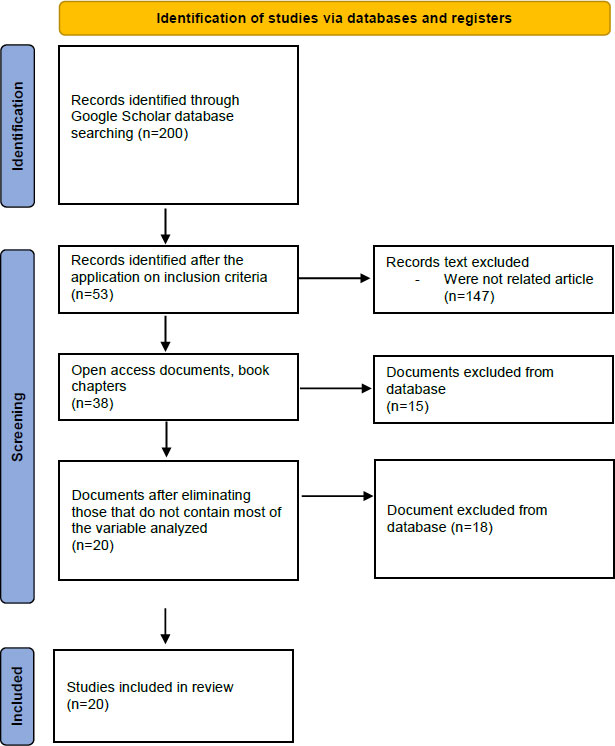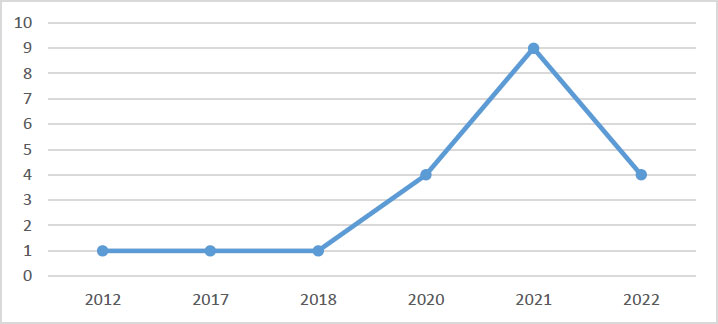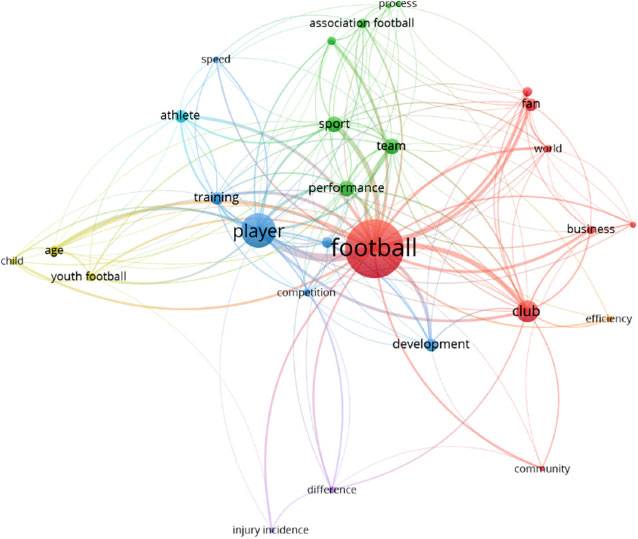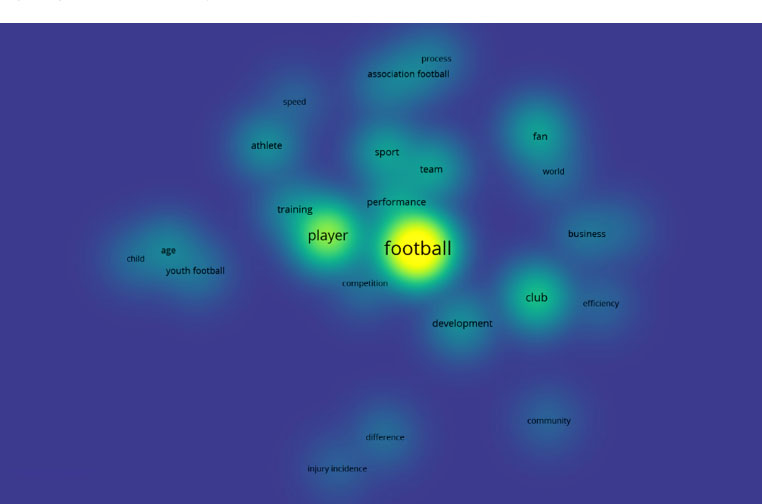All published articles of this journal are available on ScienceDirect.
Indonesian Football: A Bibliometric Analysis and Perspectives
Abstract
Background
Football is one of the most popular sports in Indonesia, where millions of people follow the game. In spite of its popularity, Indonesia has little information about the sport from the academic sector. This study gap is concerning because it limits the scholars’ ability to comprehend the effects of the sport on Indonesian society, culture, and the economy.
Methods
The formulation of plans and programs to raise the caliber and level of competition in Indonesian football is also hampered by a lack of research. In order to give some insights into how academics have so far researched Indonesian football, we undertook a bibliometric study. This article also discusses the difficulty of incorporating a sports context into the literature on social ecosystems, adding contribution by integrating ideas from previous works of literature. To get a deeper understanding of the growth of Indonesian football literature in the 2000s and 2010s, we performed a bibliometric study of football publications in several databases.
Results
The issues raised in this study will be considered in light of recent advancements in sports science, society, and technology.
Conclusion
We inferred numerous relevant subject clusters from this study, such as “training,” “competition,” and “development.” The implications of the research and its potential for future directions are also discussed in this article.
1. INTRODUCTION
Football or soccer is one of the most popular sports due to the fact that this game contains aspects of happiness, excitement, sorrow, dishonesty, and other emotions [1]. Various stakeholders are involved in a football game, including the players, backup players, coaches, managers, officials, medical personnel, media, fan clubs, and the general public [2]. To ensure that the match proceeds in accordance with the relevant regulations, all parties engaged must show respect for one another when carrying out their respective roles [3].
Nowadays, football also has an urge to be studied from a social perspective, not only as a phenomenon in sports [4]. Since 2007, there have been several important football events held in Indonesia (AFC Asian Cup 2007, Asian Games 2018, and U-17 World Cup 2023, to name a few). Football studies have also grown significantly in Indonesia, thus, scholars are interested in finding out more about how football is seen and developed there. However, there has never been any comprehensive bibliometric mapping and profiling of Indonesia's growing research output in the field of football [5]. On the other hand, sport is a field of science that is always growing in both academic and non-academic environments. The production of scientific publications makes one stand out in the academic community, thus, publication in the sector of sports business needs to be a main concern in Indonesia [6].
On the other hand, undergraduate, graduate, and doctoral students in Indonesia are required to publish in the field of science, according to Indonesian Ministry Regulation No. 152/E/T/2012, issued January 27, 2012 [7]. The output of scientific papers is impacted by this fact, and scholars must embrace this trend in order to do excellent research. Indonesian institutions annually produce a large number of graduates with degrees in sports, but students can also complete their coursework by publishing their results [8]. These publications may appear in various forms of publications, such as conference proceedings, book chapters, or journals [9]. Therefore, there are a lot of potential scholars who can take advantage of exploring Indonesian football academic literature to the world.
Having said that, carrying out this research is necessary to explore the quantity of football publications in Indonesia and observe the direction they are heading. This article provides a qualitative assessment of publication trends by using bibliometric analysis. In the next chapters, our steps will include filtering works outside of scope and highlighting the most successful authors and publications [10].
Numerous bibliometric analyses of journals have been conducted in various fields of study, but so far, there is only one bibliometric analysis of sports journals published by an Indonesian researcher (Hanief, 2021) [11]. We believe there must be a balance between the expansion of scientific journal articles and the control of the amount and quality of the material [12]. Therefore, the purpose of this study is to map the thematic coverage of Indonesian football while also examining the evolution of scholarly publications [13]. This study also provides unique bibliometric analysis data for the period of early 2012 to August 2022 and emphasizes the major trends in publications regarding Indonesian football.
2. METHODOLOGY
The sum of indications about the significance of the articles generated is widely known as “bibliometric analysis” [14, 15]. This method provides access to current advancements and potential directions in an area. It has brought a lot of attention to several computer programs that make domain analysis effective, such as CiteSpace, Publish or Perish, Biblioshiny, and HistCite, which are all popular and widely used for analyzing structural linkages and scientific development processes. The databases Scopus and Google Scholar served as the data sources for the sampling approach in our bibliometric investigation. First, we began the search using the term “Indonesian football.” However, we then decided to be flexible with the keywords by using ‘soccer’ and ‘sepak bola’ or ‘sepakbola’ (the Indonesian word for football). With this action, 20 publications were acquired, with 15 papers from Google Scholar and 5 articles from SCOPUS [16, 17]. The publication years that were selected ranged from 2012 to December 2022. (Fig. 1).
In this study, we explored co-word analysis employing keyword co-occurrence and bibliometric analysis with publication mapping [15]. They also mapped the primary contributions, including author, institution, and source name [2]. Afterwards, the process involved searching for related articles from several databases, including Google Scholar, Sinta and Garuda (Indonesian academic literature databases), and Scopus. To eliminate data ‘noise,’ the type of publication was specifically chosen as ‘articles’ to filter out unnecessary document types. We excluded documents other than articles, such as editorial materials, retraction notes, research notes and book reviews.
Next, we employed data visualization to show the data using the VOSViewer tool, which was introduced by researchers at Leiden University [18]. The following VOSViewer options were used to collect article metadata: (1) Analysis type (co-occurrence analysis), (2) Analysis unit (all keywords), (3) Analysis counting technique (full counting), and (4) Minimum number of author documents (2 documents).
3. RESULTS AND DISCUSSION
This study examines 20 publications on Indonesian football that were published between 2012 and 2022. The year 2021 saw the greatest study on Indonesian football throughout this time span, with 9 publications (45%). From 2012 and ending in 2018, there was merely one publication on Indonesian football each year. An upsurge in publications about Indonesian football was seen in 2020 and 2021 (Table 1).
According to Fig. (2), there is a trend for the number of papers to fluctuate each year. In 2018, there was an increase from 1 paper in 2021 to 9 papers, followed by a reduction to 4 papers in 2022.
| Year | Number of Paper |
|---|---|
| 2012 | 1 |
| 2015 | 1 |
| 2017 | 1 |
| 2018 | 1 |
| 2020 | 4 |
| 2021 | 8 |
| 2022 | 4 |
| Total | 20 |



| Ranking | Citation | Title | First Author | Year |
|---|---|---|---|---|
| 1 | 21 | Ultras in Indonesia: conflict, diversification, activism | Fuller, A. | 2018 |
| 2 | 15 | The politics of Indonesian and Turkish soccer: A comparative analysis. In Football in Asia | Dorsey, J. M., | 2016 |
| 2 | 8 | Psychological characteristics of athletes at Pusat Pendidikan dan Latihan Pelajar (PPLP) in Bengkulu | Nopiyanto, Y. E Raibowo, S Prabowo, G. U |
2021 |
| 3 | 8 | Soccer and the city: the game and its fans in Solo and Yogyakarta | Fuller, A. | 2017 |
| 4 | 7 | Approaching football in Indonesia | Fuller, A. | 2015 |
| 5 | 6 | Coordination and agility: How is the correlation in improving soccer dribbling skills? | Daulay, B Azmi, F |
2021 |
Fig. (3) displays the number of citations from 2012 to 2022, which can reach 38. 2012 articles have only been mentioned once in other articles. From 2020 to 2021, there is an increase in the number of citations.
Table 2 also lists the top 5 articles that have been cited the most from the time of their publication to the drafting of this essay. The name Andy Fuller stands out among those who have written three studies on Indonesian football from an anthropological standpoint [16, 17, 19, 20].
In Table 1, it is shown that Nopiyanto (2021) was the author of the sports education work with the most citations, “Psychological characteristics of athletes at Pusat Pendidikan dan Latihan Pelajar (PPLP) in Bengkulu,” which had a total of 8 citations [2]. However, the works by Fuller, ‘Ultras in Indonesia: conflict, diversification, activism,’ and Dorsey, ‘The politics of Indonesian and Turkish soccer: A comparative analysis’ show that football in Indonesia can also be discussed from a socioeconomic and political perspective.
A journal's citation count is important for its reputation since it enables one to assess the journal's impact on scientific development [10]. This cannot be isolated from the journal's primary focus and scope in any way [19-21]. The articles that have been evaluated are also categorized according to the writers who have contributed to the connected topic. Table 2 lists the top 10 most productive authors who have published articles on the topic of Indonesian football during the past ten years.

Based on Table 3, the top author is still Fuller, A., who wrote 3 papers, which were titled “Approaching Football in Indonesia,” “Ultras in Indonesia: conflict, diver-sification, activism,” and “Soccer and the City: the game and its fans in Solo and Yogyakarta” [16, 17, 20]. Next, each of the following authors wrote 1 paper. The first one is Fatchurrohim, A. A., with a paper titled “Tingkat Kesegaran Jasmani Pemain Klub Sepak Bola Dayo FC (in English: ‘Players’ Physical Freshness Level of Dayo FC Football Club’) [22]. Daulay, B., wrote 1 paper which was titled “Coordination and agility: How is the correlation in improving soccer dribbling skills?” [1]. The last one is Ferrari in the article “Traditional and mediatized soccer fanship: The case of Indonesian Juventus’ supporters” [19].
| Author | Number of Paper |
|---|---|
| Fuller, A. | 3 |
| Fatchurrohim, A. A | 1 |
| Daulay, B | 1 |
| Umar, F | 1 |
| Ferrari, S. | 1 |
By using a co-occurrence analysis kind of phrase, we were able to get 50 keywords with at least one co-occurrence by employing the full counting technique [23]. The co-occurrence analysis of keywords is used to demonstrate the frequency of terms used in publications [24]. The search returned 50 keywords, but they were later eliminated because they didn't fit the journal's focus, leaving only 30 pertinent terms. Fig. (4) display of the co-occurrence data for keywords visually presents this result.
We follow the visualization of bibliometrics from the previous works of literature [25, 26]. Fig. (4) is used to determine which terms are frequently used [27]. The most often appearing terms are “football,” “player,” and “club,” according to an analysis of co-occurrence (keyword co-occurrence) shown in Fig. (4).
Fig. (5) shows the density of related terms as well as the number of nodes that are near to one another [15]. The yellow nodes, which display the level of saturation, reflect the number of phrases that appear often [28]. The most commonly occurring term, “Football,” is in the yellow node, suggesting that this topic has attracted the most investigation. Different topics, such as “development,” “competition,” and “training,” are covered by the green nodes. Green nodes represent topics that have not undergone substantial research [29].

If the scientific specialization of each reviewer is not suitable, the review's results will not be optimal, especially in terms of substance [30]. The introduction of these topics provides editors with evaluation data as they work to narrow the journal's scope and make it more specialized [31]. Additionally, editors pick editors and reviewers whose scientific expertise coincides with the topics depicted in Fig. (5) on the basis of this density visualization [32].
CONCLUSION
The results of this study add to our knowledge of Indonesian football's historical development and current state as observed via scholarly discourse. This result is noteworthy because it provides a broad overview of the articles, authors, and journals with the largest number of publications and citations, based on a survey of 20 papers in the Google Scholar and SCOPUS databases. Choosing the areas of study for Indonesian football research is another of its most significant accomplishments. This study also demonstrates to the general public how bibliometric analysis can be used to map out the trajectory of publication development in the field of football [33]. This study identifies thematic themes and subjects that appear in publications and offers information on important concerns for further research, theory development, and educational practice. The productivity of publications between 2012 and 2022, when the average number of publications per year was still under 10, shows that Indonesian football is a study area that is interesting to be extended.
The lack of academic research on football in Indonesia can be attributed to several factors, including a lack of funding, limited interest from researchers, and a general perception that sports research is not a priority. The lack of research has resulted in a lack of data and information about the sport, which makes it difficult for policymakers, coaches, and athletes to make informed decisions [33]. Addressing this gap in research requires a concerted effort from various stakeholders, including universities, sports organizations, and the government [34, 35]. Researchers should be encouraged to explore the many facets of football in Indonesia, including the social, cultural, and economic dimensions of the sport. Funding for research should be made available, and sports organizations should collaborate with researchers to ensure that research findings are integrated into their strategies and policies [36].
In conclusion, the lack of research on football in Indonesia is a significant issue that needs to be addressed urgently. Without comprehensive and extensive research, we cannot fully understand the impact of football on Indonesian society, culture, and economy, nor can we develop strategies and policies to improve the quality and competitiveness of Indonesian football. It is time for interested parties to acknowledge the value of sports research and move to close this information gap. The Fédération Internationale de Football Association (FIFA) built an official representative office in Jakarta, Indonesia, in 2023, which presents another excellent chance to investigate further empirical research. Finally, there has to be a significant expansion of the literature in this field because Indonesia hosted.
LIST OF ABBREVIATIONS
| PPLP | = Pusat Pendidikan dan Latihan Pelajar |
| FIFA | = Fédération Internationale de Football Association |
CONSENT FOR PUBLICATION
Not applicable.
STANDARDS OF REPORTING
PRISMA guidelines and methodology were followed.
AVAILABILITY OF DATA AND MATERIALS
The data supporting the findings of the article is available in the Telkom University repository at staff.telkomuniversity.ac.id , reference number 00266.
FUNDING
This study was funded by Telkom University. Funder ID: Tel-U, Awards/Grant number: 00266/ABD04/PPM-JPM/2023.
CONFLICT OF INTEREST
The authors declare no conflict of interest, financial or otherwise.
ACKNOWLEDGEMENTS
Declared none.
SUPPLEMENTARY MATERIAL
PRISMA checklist is available as supplementary material on the publisher’s website along with the published article.
Supplementary material is available on the publisher’s website along with the published article.


